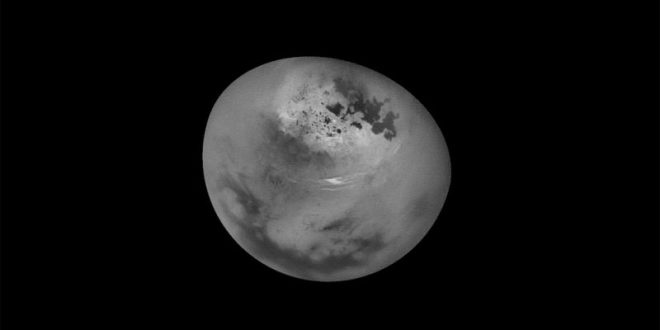NASA’ Cassini time-lapse video shows clouds in motion over Titan’s northern region.
NASA’s Cassini spacecraft caught clouds of methane moving across the surface of Titan, Saturn’s largest moon. In the time-lapse video, you can see clouds coming in and out of the movie sequence that was composed of photos taken every 20 minutes for 11 hours.
For the most part, cloud activity remains persistent throughout the course of the observations, but some individual streaks appear to develop and fade over time. Those particular clouds traveled at speeds of between 14 to 22 miles per hour (7 to 10 meters per second). Furthermore, a handful of smaller clouds also appear over a group of small lakes further to the north, according to JPL.
Those clouds, which include one particularly bright group that appeared between the areas called Neagh Lacus and Punga Mare, were seen moving at a velocity of nearly 0.7 to 1.4 miles per hour (1 to 2 meters per second) by the Cassini orbiter’s two onboard cameras, the agency added.
New observations provide best chance to study cloud dynamics
While this new video does not mark the first time that Cassini has observed clouds moving over the northern mid-latitudes of Titan, as it has done so multiple times earlier this year, NASA said that it provides the best opportunity so far to study the dynamics of these short-term clouds.
Prior to these observations, most of the cloud sightings were short images captured days or even weeks apart, they noted. This time-lapse video, on the other hand, will allow scientists to observe the dynamics of the clouds while also allowing them to distinguish between noise in images (for instance, cosmic rays hitting the orbiter’s instruments) and faint clouds of methane.
“Models of Titan’s climate have predicted more cloud activity during early northern summer than what Cassini has observed so far,” scientists at the California-based lab said, “suggesting that the current understanding of the giant moon’s changing seasons is incomplete.” Cassini will continue to monitor Titan’s weather throughout the moon’s its 2017 summer solstice, they added.
Cassini, a cooperative project operated by NASA, the European Space Agency (ESA) and the Italian Space Agency, was the fourth spacecraft to visit the Saturn system, as well as the first to enter the planet’s orbit. It arrived at Saturn in 2004 and will end its mission in September 2017, when it takes one final dive between the planet and its rings, according to NASA.
“No other mission has ever explored this unique region so close to the planet. What we learn from these activities will help to improve our understanding of how giant planets – and families of planets everywhere – form and evolve,” the agency added. “It’s inspiring, adventurous and romantic – a fitting end to this thrilling story of discovery.”
Agencies/Canadajournal

 Canada Journal – News of the World Articles and videos to bring you the biggest Canadian news stories from across the country every day
Canada Journal – News of the World Articles and videos to bring you the biggest Canadian news stories from across the country every day

